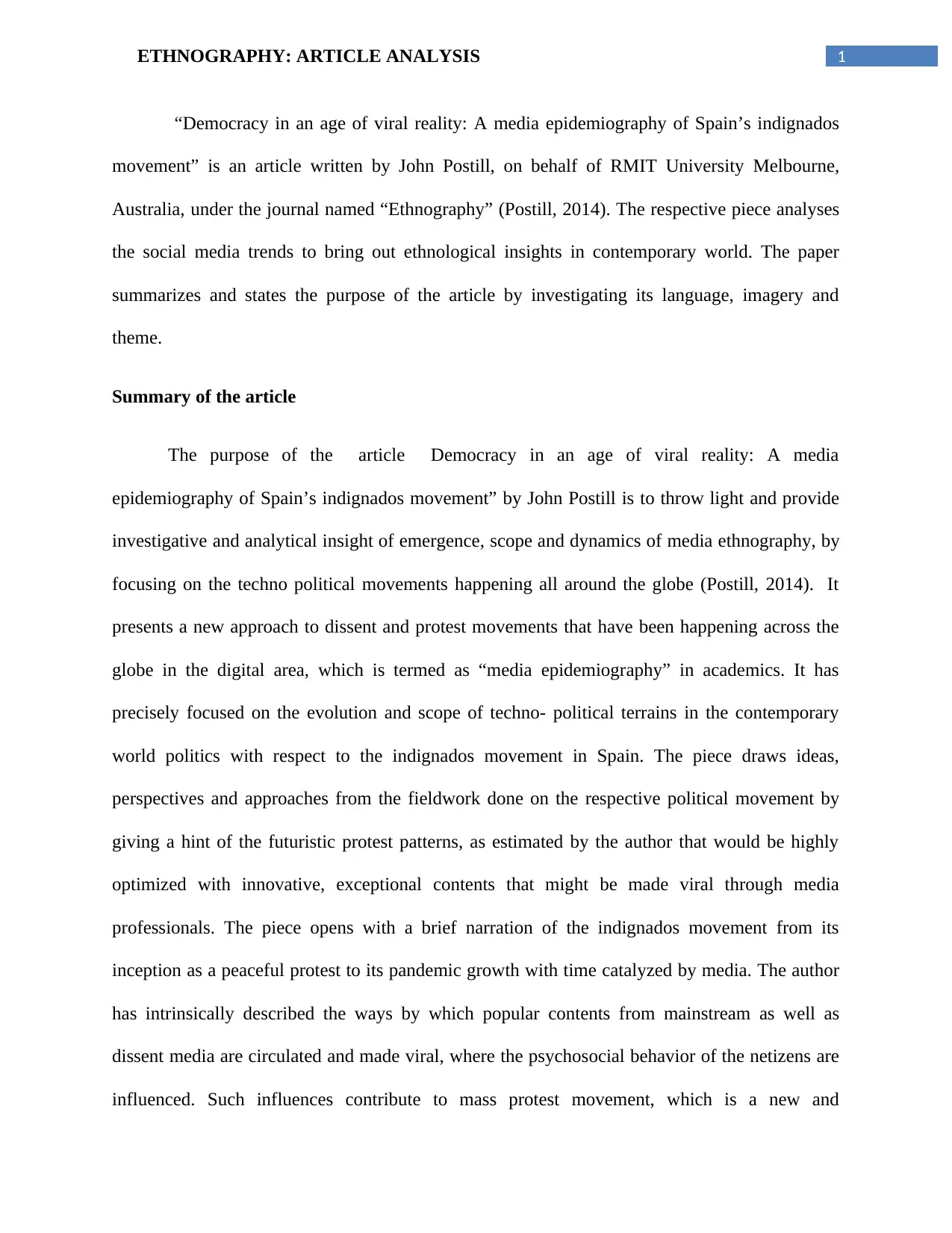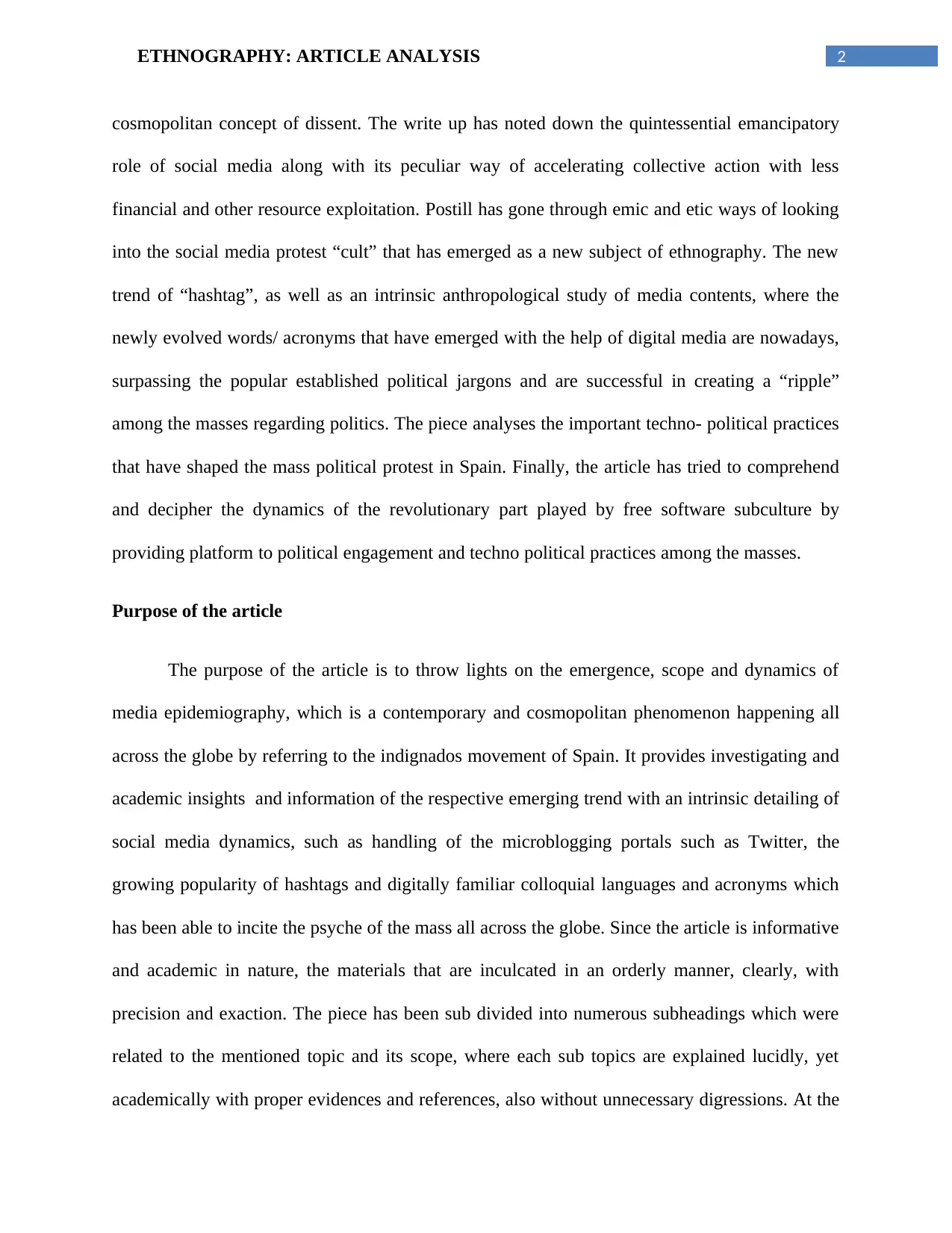Ethnography Article Analysis 2022
VerifiedAdded on 2022/10/19
|5
|1028
|12
AI Summary
Contribute Materials
Your contribution can guide someone’s learning journey. Share your
documents today.

Running head: ETHNOGRAPHY: ARTICLE ANALYSIS
ETHNOGRAPHY: ARTICLE ANALYSIS
Name of the student
Name of the University
Author Note
ETHNOGRAPHY: ARTICLE ANALYSIS
Name of the student
Name of the University
Author Note
Secure Best Marks with AI Grader
Need help grading? Try our AI Grader for instant feedback on your assignments.

1ETHNOGRAPHY: ARTICLE ANALYSIS
“Democracy in an age of viral reality: A media epidemiography of Spain’s indignados
movement” is an article written by John Postill, on behalf of RMIT University Melbourne,
Australia, under the journal named “Ethnography” (Postill, 2014). The respective piece analyses
the social media trends to bring out ethnological insights in contemporary world. The paper
summarizes and states the purpose of the article by investigating its language, imagery and
theme.
Summary of the article
The purpose of the article Democracy in an age of viral reality: A media
epidemiography of Spain’s indignados movement” by John Postill is to throw light and provide
investigative and analytical insight of emergence, scope and dynamics of media ethnography, by
focusing on the techno political movements happening all around the globe (Postill, 2014). It
presents a new approach to dissent and protest movements that have been happening across the
globe in the digital area, which is termed as “media epidemiography” in academics. It has
precisely focused on the evolution and scope of techno- political terrains in the contemporary
world politics with respect to the indignados movement in Spain. The piece draws ideas,
perspectives and approaches from the fieldwork done on the respective political movement by
giving a hint of the futuristic protest patterns, as estimated by the author that would be highly
optimized with innovative, exceptional contents that might be made viral through media
professionals. The piece opens with a brief narration of the indignados movement from its
inception as a peaceful protest to its pandemic growth with time catalyzed by media. The author
has intrinsically described the ways by which popular contents from mainstream as well as
dissent media are circulated and made viral, where the psychosocial behavior of the netizens are
influenced. Such influences contribute to mass protest movement, which is a new and
“Democracy in an age of viral reality: A media epidemiography of Spain’s indignados
movement” is an article written by John Postill, on behalf of RMIT University Melbourne,
Australia, under the journal named “Ethnography” (Postill, 2014). The respective piece analyses
the social media trends to bring out ethnological insights in contemporary world. The paper
summarizes and states the purpose of the article by investigating its language, imagery and
theme.
Summary of the article
The purpose of the article Democracy in an age of viral reality: A media
epidemiography of Spain’s indignados movement” by John Postill is to throw light and provide
investigative and analytical insight of emergence, scope and dynamics of media ethnography, by
focusing on the techno political movements happening all around the globe (Postill, 2014). It
presents a new approach to dissent and protest movements that have been happening across the
globe in the digital area, which is termed as “media epidemiography” in academics. It has
precisely focused on the evolution and scope of techno- political terrains in the contemporary
world politics with respect to the indignados movement in Spain. The piece draws ideas,
perspectives and approaches from the fieldwork done on the respective political movement by
giving a hint of the futuristic protest patterns, as estimated by the author that would be highly
optimized with innovative, exceptional contents that might be made viral through media
professionals. The piece opens with a brief narration of the indignados movement from its
inception as a peaceful protest to its pandemic growth with time catalyzed by media. The author
has intrinsically described the ways by which popular contents from mainstream as well as
dissent media are circulated and made viral, where the psychosocial behavior of the netizens are
influenced. Such influences contribute to mass protest movement, which is a new and

2ETHNOGRAPHY: ARTICLE ANALYSIS
cosmopolitan concept of dissent. The write up has noted down the quintessential emancipatory
role of social media along with its peculiar way of accelerating collective action with less
financial and other resource exploitation. Postill has gone through emic and etic ways of looking
into the social media protest “cult” that has emerged as a new subject of ethnography. The new
trend of “hashtag”, as well as an intrinsic anthropological study of media contents, where the
newly evolved words/ acronyms that have emerged with the help of digital media are nowadays,
surpassing the popular established political jargons and are successful in creating a “ripple”
among the masses regarding politics. The piece analyses the important techno- political practices
that have shaped the mass political protest in Spain. Finally, the article has tried to comprehend
and decipher the dynamics of the revolutionary part played by free software subculture by
providing platform to political engagement and techno political practices among the masses.
Purpose of the article
The purpose of the article is to throw lights on the emergence, scope and dynamics of
media epidemiography, which is a contemporary and cosmopolitan phenomenon happening all
across the globe by referring to the indignados movement of Spain. It provides investigating and
academic insights and information of the respective emerging trend with an intrinsic detailing of
social media dynamics, such as handling of the microblogging portals such as Twitter, the
growing popularity of hashtags and digitally familiar colloquial languages and acronyms which
has been able to incite the psyche of the mass all across the globe. Since the article is informative
and academic in nature, the materials that are inculcated in an orderly manner, clearly, with
precision and exaction. The piece has been sub divided into numerous subheadings which were
related to the mentioned topic and its scope, where each sub topics are explained lucidly, yet
academically with proper evidences and references, also without unnecessary digressions. At the
cosmopolitan concept of dissent. The write up has noted down the quintessential emancipatory
role of social media along with its peculiar way of accelerating collective action with less
financial and other resource exploitation. Postill has gone through emic and etic ways of looking
into the social media protest “cult” that has emerged as a new subject of ethnography. The new
trend of “hashtag”, as well as an intrinsic anthropological study of media contents, where the
newly evolved words/ acronyms that have emerged with the help of digital media are nowadays,
surpassing the popular established political jargons and are successful in creating a “ripple”
among the masses regarding politics. The piece analyses the important techno- political practices
that have shaped the mass political protest in Spain. Finally, the article has tried to comprehend
and decipher the dynamics of the revolutionary part played by free software subculture by
providing platform to political engagement and techno political practices among the masses.
Purpose of the article
The purpose of the article is to throw lights on the emergence, scope and dynamics of
media epidemiography, which is a contemporary and cosmopolitan phenomenon happening all
across the globe by referring to the indignados movement of Spain. It provides investigating and
academic insights and information of the respective emerging trend with an intrinsic detailing of
social media dynamics, such as handling of the microblogging portals such as Twitter, the
growing popularity of hashtags and digitally familiar colloquial languages and acronyms which
has been able to incite the psyche of the mass all across the globe. Since the article is informative
and academic in nature, the materials that are inculcated in an orderly manner, clearly, with
precision and exaction. The piece has been sub divided into numerous subheadings which were
related to the mentioned topic and its scope, where each sub topics are explained lucidly, yet
academically with proper evidences and references, also without unnecessary digressions. At the

3ETHNOGRAPHY: ARTICLE ANALYSIS
end of the article, a list of notes and evidences has been provided as an aid to cross reference.
The intended audience (reader) of the write up is supposed to be anthropologists, ethnographers,
research scholars, students, sociologists, social scientists and media researchers. The piece has
been written in a highly academic way with precision and very little digression. Such writing
patterns have been inculcated in order to cater the reading needs of the academics, researchers,
professionals and students pursuing higher education. It has provided an in-depth knowledge
regarding media and its role in ethnography, specifically to cater to the needs of the academics,
and professionals who are associated with academics and need highly optimized and analyzed
data/ information. The piece is not only informative, but also analytical, where the author has
utilized different figures of speech such as imageries and metaphors, showing the correct
utilization of academic writing skills for providing a better picture of the information written.
Article’s relation with the theme
The article intrinsically and instrumentally covers the topic of utility or usage of media in
anthropology as the piece has covered the primary and secondary, emic and etic approaches of
anthropological and ethnographic studies by blending the concept of popular media in them.
With the usage of context of the “techno- political” movements happening across the globe, the
author has provided the accurate and appropriate information and evidence to justify the
emerging approach of ethnography viewed on the lights of mass media culture and dynamics.
end of the article, a list of notes and evidences has been provided as an aid to cross reference.
The intended audience (reader) of the write up is supposed to be anthropologists, ethnographers,
research scholars, students, sociologists, social scientists and media researchers. The piece has
been written in a highly academic way with precision and very little digression. Such writing
patterns have been inculcated in order to cater the reading needs of the academics, researchers,
professionals and students pursuing higher education. It has provided an in-depth knowledge
regarding media and its role in ethnography, specifically to cater to the needs of the academics,
and professionals who are associated with academics and need highly optimized and analyzed
data/ information. The piece is not only informative, but also analytical, where the author has
utilized different figures of speech such as imageries and metaphors, showing the correct
utilization of academic writing skills for providing a better picture of the information written.
Article’s relation with the theme
The article intrinsically and instrumentally covers the topic of utility or usage of media in
anthropology as the piece has covered the primary and secondary, emic and etic approaches of
anthropological and ethnographic studies by blending the concept of popular media in them.
With the usage of context of the “techno- political” movements happening across the globe, the
author has provided the accurate and appropriate information and evidence to justify the
emerging approach of ethnography viewed on the lights of mass media culture and dynamics.
Secure Best Marks with AI Grader
Need help grading? Try our AI Grader for instant feedback on your assignments.

4ETHNOGRAPHY: ARTICLE ANALYSIS
References
Postill, J. (2014). Democracy in an age of viral reality: A media epidemiography of Spain’s
indignados movement. Ethnography, 15(1), 51-69.
References
Postill, J. (2014). Democracy in an age of viral reality: A media epidemiography of Spain’s
indignados movement. Ethnography, 15(1), 51-69.
1 out of 5
Your All-in-One AI-Powered Toolkit for Academic Success.
+13062052269
info@desklib.com
Available 24*7 on WhatsApp / Email
![[object Object]](/_next/static/media/star-bottom.7253800d.svg)
Unlock your academic potential
© 2024 | Zucol Services PVT LTD | All rights reserved.